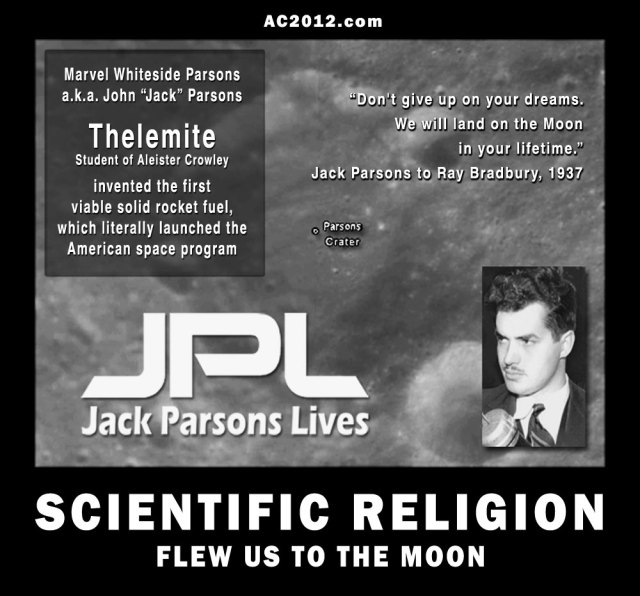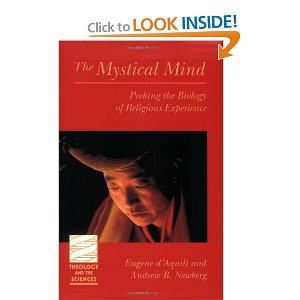Out of all the candidates in this election, Aleister Crowley is the most interested in applying science to politics and religion. In this post, we will explore Aleister Crowley’s ideas about the scientific basis of religious experience, applying science to politics, and the indirect influence that Crowley’s philosophy has had on scientific advancements.
Science and Religion
In popular culture today, we often find ourselves presented with a false dilemma which positions rationalism and science against religion and dogma, as if these were two mutually exclusive paradigms.
Aleister Crowley, however, did not see science and religion as incompatible, and as early as 1903, the year before he was to found the scientific religion of Thelema, he was already looking for examples of scientific religion. In his essay, “Science and Buddhism,” he set out to demonstrate that “… Buddhism, alike in theory and practice, is a scientific religion; a logical superstructure on a basis of experimentally verifiable truth; and that its method is identical with that of science.”
Later, in his publication of The Equinox I, no. 1, Aleister Crowley made a further effort to distinguish between scientific religion and superstitious religion:
“The Christian insists on notorious lies being accepted as an essential part of his (more usually her) system; I, on the contrary, ask for facts, for observation. Under Scepticism, true, one is just as much a house of cards as the other; but only in the philosophical sense.
“Practically, Science is true; and Faith is foolish.
…
“Practically, ‘I concentrated my mind upon a white radiant triangle in whose centre was a shining eye, for 22 minutes and 10 seconds, my attention wandering 45 times’ is a scientific and valuable statement. ‘I prayed fervently to the Lord for the space of many days’ means anything or nothing. Anybody who cares to do so may imitate my experiment and compare his result with mine. In the latter case one would always be wondering what ‘fervently’ meant and who ‘the Lord’ was, and how many days made ‘many.'”
— “The Soldier and the Hunchback: ! and ?” by Aleister Crowley

The cover image of the newly released second edition of IAO131’s book, Naturalistic Occultism, features this “Atomic Unicursal Hexagram” image by Frater Enatheleme
For a recent analysis of the relationship between science, religion, and magick, we can turn to the short essay, “Science, Religion, and Thelema” by T Polyphilus, where he explains, “It makes sense that the very concept of magic which had been used to insulate science and religion from one another, should also be the medium through which they might be integrated. And in fact, that is exactly the desire that is evident in modern occultism.”
Also of interest to those who want to learn more about occultism from a naturalistic perspective is the book by IAO131 entitled Naturalistic Occultism, which is now available in an expanded second edition. Visit IAO131’s website for more information.
The Neuroscience of Religious Experience
“I further take this opportunity of asserting my Atheism. I believe that all these phenomena are as explicable as the formation of hoar-frost or of glacier tables. I believe ‘Attainment’ to be a simple supreme sane state of the human brain. I do not believe in miracles; I do not think that God could cause a monkey, clergyman, or rationalist to attain. I am taking all this trouble of the Record principally in hope that it will show exactly what mental and physical conditions precede, accompany, and follow ‘attainment’ so that others may reproduce, through those conditions, that Result.”
— John St. John: The Record of the Magical Retirement of G. H. Frater, O∴ M∴
Aleister Crowley was a pioneer in applying scientific principles to religious studies (particularly the religious experience), including but not limited to yoga and magick.
Some of Aleister Crowley’s theories in the realm of comparative religion were later found to be incorrect ( like many of his contemporaries such as J.G. Frazer). His ideas about the religious experience, however, have today been verified by the work of neuroscientist Dr. Andrew Newberg. Dr. Newberg independently came to the same conclusions as Crowley about why it is that practices such as yoga and magick bring about religious experiences.
Aleister Crowley said that the religious experience is similar to other phenomenological experiences and may therefore be open to scientific analysis. He proposed that religious experience may be caused by specific neurochemical changes.
“Now, Samadhi, whatever it is, is at least a state of mind exactly as are deep thought, anger, sleep, intoxication and melancholia. Very good. Any state of mind is accompanied by corresponding states of the body. … we already know that certain spiritual or mental conditions may be induced by acting on physico- and chemico-physiological conditions. For instance, we can make a man hilarious, angry or what not by giving him whisky. We can induce sleep by administering such drugs as veronal. We can even give him the courage of anaesthesia (if we want him to go over the top) by means of ether, cocaine and so on. We can produce fantastic dreams by hashish, hallucinations of colour by anhalonium lewinii; we can even make him ‘see stars’ by the use of a sandbag. Why then should we not be able to devise some pharmaceutical, electrical or surgical method of inducing Samadhi; create genius as simply as we do other kinds of specific excitement? Morphine makes men holy and happy in a negative way; why should there not be some drug which will produce the positive equivalent?”
— The Confessions of Aleister Crowley: an Autohagiography, Chapter 48
This conjecture of Aleister Crowley’s has been proven by Dr. Andrew Newberg, who found that the Orientation Association Area (OAA) of the brain goes dark when people have religious experiences. Dr. Newberg found this to be true in widely diverse practices such as: Pentecostal Christians feeling the presence of the Holy Ghost during glossolalia; Carmelite nuns having the sense of being united with God through ecstatic prayer; and Tibetan monks’ experience of annihilation in Samadhi after prolonged periods of meditation.
Aleister Crowley went further to describe the phenomenon of Genius or Samadhi as one which can be attained through two main avenues: quieting the mind, or exciting it. In either case, the goal is to unite subject and object.
“We assert a secret source of energy which explains the phenomenon of Genius … We do not believe in any supernatural explanations, but insist that this source may be reached by the following out of definite rules, the degree of success depending on the capacity of the seeker, and not upon the favour of any Divine Being. We assert that the critical phenomenon which determines success is an occurrence in the brain characterized essentially by the uniting of subject and object.”
— Liber ABA, Part 1, “Mysticism: Meditation: The Way of Attainment of Genius or Godhead Considered as a Development of the Human Brain”
The first method, yoga, works by quieting the mind. It shuts out information by controlling posture, breath, focus and so on. As Aleister Crowley writes in the final chapter of his Magick Without Tears:
“In Yoga, various practices prevent the body and its functions from interrupting the mental process. Then, one inhibits that process itself: the stilling of ‘thoughts’ allows one to become aware of mental functions beyond the intellectual; these functions have their own peculiar properties and powers. Each sheath, as one goes deeper, is discarded as ‘unreal;’ finally one apprehends that nothing which is the only true and real form of existence.”
Dr. Newberg has also demonstrated that meditation works by quieting the mind & body, which results in the Orientation Association Area of the brain (OAA) shutting down. Once the experience of Samadhi occurs, the OAA is almost completely dark.
Aleister Crowley goes on to explain in Magick Without Tears that magick works by inflaming the mind. That is, it overwhelms the mind with “energized enthusiasm.”
“Magick explores and learns to control those regions of Nature which lie beyond the objects of sense. Reaching the highest parts of these regions, called the divine, one proceeds by the exaltation … of the consciousness to identify oneself with those ‘celestial’ Beings.”
This too has been demonstrated by Dr. Newberg, in the case of ecstatic prayer and glossolalia, which inflame the mind by causing a kind of information overload, which results in the OAA shutting down. The brain then has no choice but to experience itself as timeless and boundless. The experience takes the form of the cultural paradigm in which the individual in question is immersed.
The fact that these religious experiences take the form of the individual’s cultural paradigm is also inherent in Crowley’s system, as it is written in Liber B vel Magi, “according to His Original Nature.”
Aleister Crowley is the first to propose a combination of both quieting the mind and inflaming it in order to reach Godhead. His system suggests in Liber Tzaddi that we “achieve both weddings” and that we “stand between the abyss of height and the abyss of depth.” For more on this idea of “the upright and the averse,” listen to this talk on the subject by Frater Puck:
Adepts of Crowley’s system “stand upright; their head above the heavens, their feet below the hells.”
Magick and the Laws of Nature
Aleister Crowley’s system of magick works alongside, and with, the laws of nature.
Unlike most other religious paths, Thelema does not have us set the laws of nature aside, even temporarily, in our practices. Aleister Crowley admonishes us to study science and logic, so that our philosophy is not based on pretentious ignorance:
“[The Postulant’s] rational mind should have been trained thoroughly in intellectual apprehension: that is, he should be familiar with all Science. … Then by analogy, fortified by contemplation, a certain inner apprehension of the Unity of Nature may grow up in the mind, one which will not be unduly presumptuous and misleading. …
“Those, therefore, who effect to despise ‘profane’ Science are themselves despicable. It is their own incapacity for true Thought of any serious kind, their vanity and pertness; nay more also! their own subconscious sense of their own shame and idleness, that induces them to build these flimsy fortifications of pretentious ignorance.”
— “Wonder” in Little Essays Towards Truth, by Aleister Crowley
In Crowley’s essay entitled “The Initiated Interpretation of Ceremonial Magick,” published in his Illustrated Goetia, he proposes that demons are parts of ourselves. When we evoke a demon to become better at mathematics, for example, what we are actually doing is commanding the part of ourselves that has capacity for mathematics to improve.
Unlike many ideas in the “new age” movement, Aleister Crowley’s philosophy does not propose that everything in one’s mind is “real.” Rather, things only are real in so far as they have a natural conduit and manifestation in the material world. As he writes in Liber O vel Manus et Saggitae:
“In this book it is spoken of the Sephiroth and the Paths; of Spirits and Conjurations; of Gods, Spheres, Planes, and many other things which may or may not exist.
“It is immaterial whether these exist or not. By doing certain things certain results will follow; students are most earnestly warned against attributing objective reality or philosophic validity to any of them.”
Aleister Crowley also pioneered the use of a diary as a phenomenological study of ones own experiences, advising us to approach these experiences with scientific inquiry and skepticism.
“Study Logic, which is the Code of the Laws of Thought. Study the Method of Science, which is the Application of Logic to the Facts of the Universe. Think not that thou canst ever abrogate these Laws, for though they be Limitations, they are the rules of thy Game which thou dost play.”
— Liber Aleph, “De Ratione Magi Vitae”
Scientific Religion Flew Us to the Moon
A popular t-shirt these days proclaims that science flies us to the moon, while religion flies us into buildings. This is, of course, a propagandistic repetition of the false dichotomy of science and religion. The reality is quite a bit more interesting. Scientific religion flew us to the moon. The founder of Jet Propulsion Laboratory and inventor of the first viable solid rocket fuel — the man who literally launched the American space program — was Jack Parsons, a prominent student of Aleister Crowley and a Thelemite.

Marvel Whiteside Parsons, a.k.a. John “Jack” Parsons, was a Thelemite and student of Aleister Crowley. He was a co-founder of the company that was to become Jet Propulsion Laboratory (JPL), and invented the first viable solid rocket fuel, literally launching the American space program.
Applying Science to Politics
Aleister Crowley also proposed, far ahead of his time, that social organisation be done along scientific lines. He envisioned branches of government wherein scientific tests are used to analyze individuals and discover their particular aptitudes. Such application of scientific approaches to government only came about after World War II.
Provided that scientific research does not infringe on the liberty of individuals to govern themselves in accordance with their own law, all such research would be allowed by Aleister Crowley’s government. If elected, Aleister Crowley would ensure that there would be few if any restrictions on scientific research.
Be sure to also listen to the Mindcore Studios interview with AC2012 creator Frater Enatheleme where many of the topics covered in this post are discussed.









Pingback: Science and Religion — Aleister Crowley 2012 | Thelema in Russia
Pingback: Why Thelema Kicks Ass – Bio Magic
Pingback: Occult Trajectories: Magic and modernity | Back Country Voices
Hi… nice site..can someone point me in the right direction… Where does1start to find1’s true life purpose.
Pingback: LAM I AM | Aleister Crowley 2012
Pingback: Why Thelema Kicks Ass | The Homepage of IAO131
Pingback: Science and Religion « Die Elektrischen Vorspiele
Pingback: The Prophet’s Political Platform | Aleister Crowley 2012